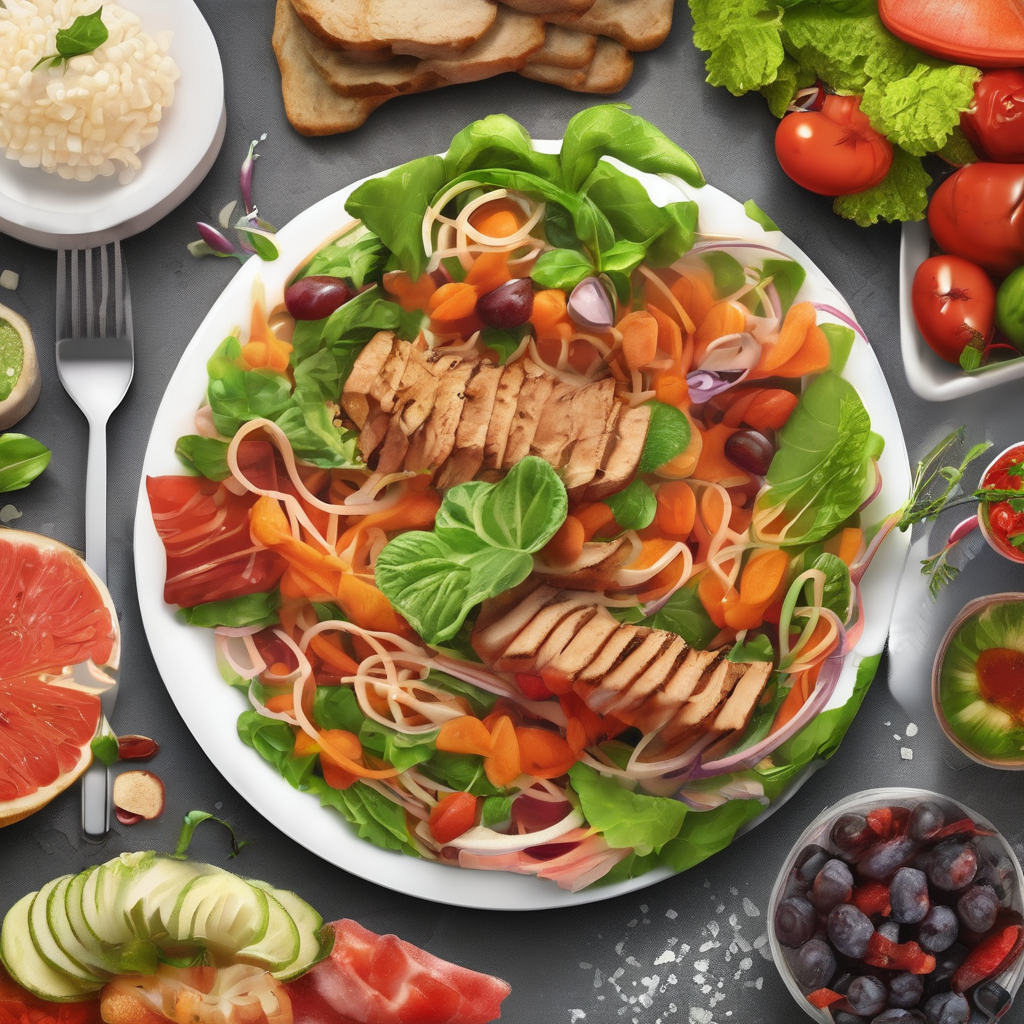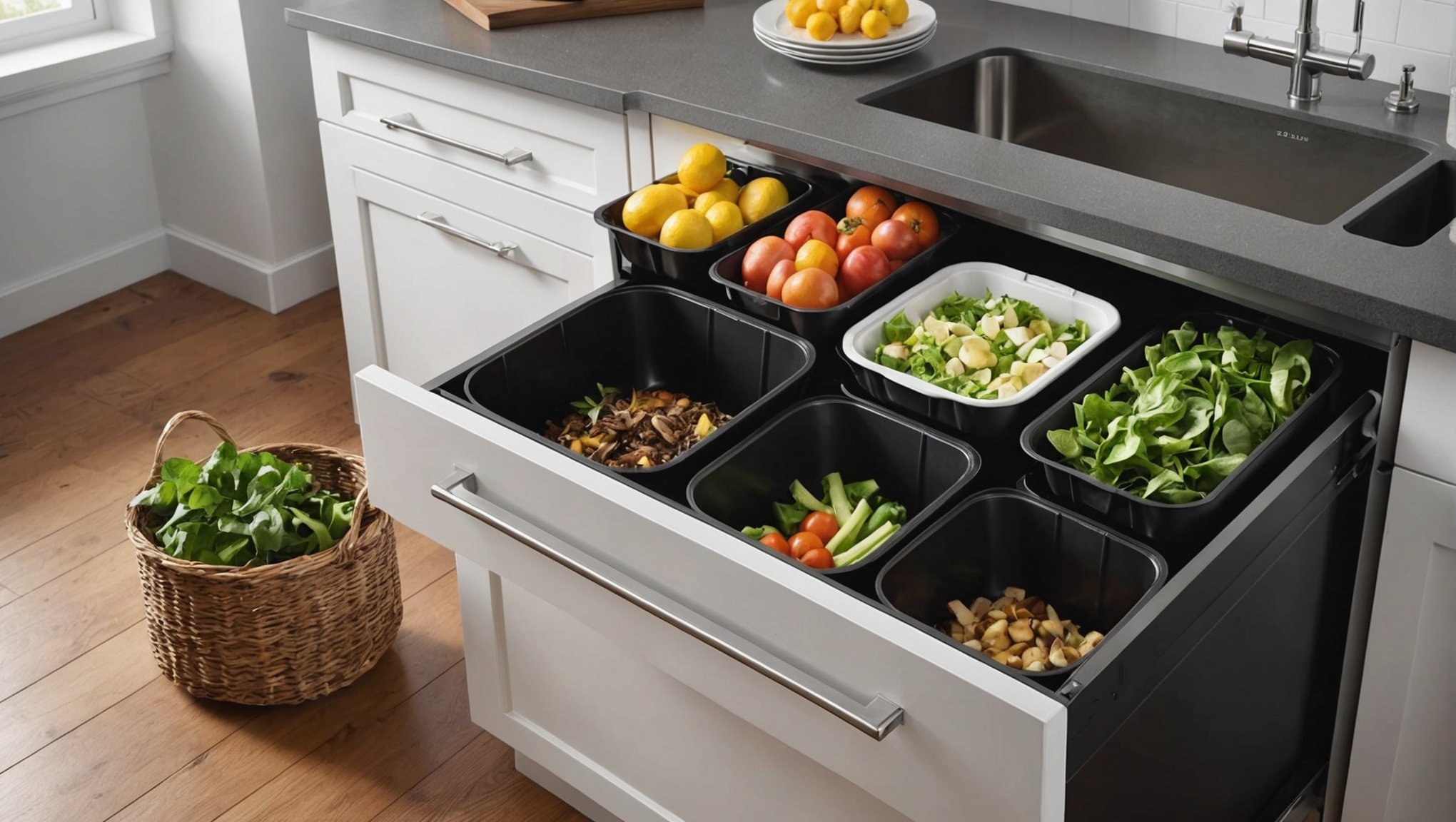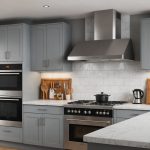Recycling and composting can seamlessly fit into your kitchen’s design, enhancing both functionality and aesthetics. Discover practical tips that transform clutter into streamlined solutions. From designated spaces for sorting waste to stylish compost bins, innovative design has the power to inspire sustainable habits. These simple yet effective changes not only promote an eco-friendly lifestyle but also elevate your kitchen’s overall appeal. Embrace the challenge of creating an effortlessly organized, environmentally conscious space that reflects your values.
Innovative Kitchen Design Ideas
In the world of kitchen design, embracing sustainable living has become more than just a trend—it’s a necessity. Prioritising eco-friendly solutions not only benefits the environment but also enhances the functionality and aesthetics of your kitchen.
Also to discover : Transform Your Kitchen’s Atmosphere with the Magic of Multi-Color LED Lighting
One key aspect of sustainable kitchen design is integrating recycling and composting systems seamlessly into the kitchen layout. By incorporating designated areas for waste separation, you can make recycling a natural part of your daily routine. This can be achieved through built-in recycling bins or pull-out composting drawers, which keep the kitchen tidy while promoting environmental responsibility.
Maximizing space is another crucial element of innovative kitchen design. With clever storage solutions, such as vertical shelving and multi-functional furniture, you can create a more efficient and organised kitchen. These designs not only increase storage capacity but also ensure that every inch of space is utilised effectively, making your kitchen both practical and visually appealing.
Also to read : Transform Your Kitchen Layout: Unlocking Energy Savings Through Smart Design
By focusing on these sustainable and space-saving strategies, you can transform your kitchen into a modern, eco-friendly haven. Embracing these innovative design concepts will not only enhance your kitchen’s functionality but also contribute positively to the planet.
Space-Saving Solutions for Recycling and Composting
Incorporating space optimization techniques in your kitchen can significantly enhance its functionality and efficiency. One effective strategy is to utilise vertical space for recycling bins. By stacking bins vertically, you can save floor space and keep your kitchen organised. This approach not only maximises storage capacity but also makes sorting recyclables more convenient.
Hidden storage solutions are essential for maintaining a clutter-free kitchen. For composting units, consider integrating pull-out drawers or cabinets designed specifically for compost storage. These discreet options keep composting out of sight while ensuring easy access. By incorporating such storage solutions, you can maintain a tidy kitchen and promote eco-friendly habits.
Multi-functional furniture is another innovative way to save space in the kitchen. For instance, kitchen islands with built-in storage compartments can serve as both a workspace and a storage unit. This dual-purpose furniture allows you to maximise kitchen efficiency without compromising on style or functionality. Additionally, foldable tables or chairs can be stored away when not in use, providing flexibility and freeing up valuable space.
By embracing these strategies, you can create a kitchen that is both efficient and environmentally responsible, making the most of every inch of space while supporting sustainable living practices.
Aesthetic Integration of Recycling and Composting Bins
Creating a visually appealing kitchen while maintaining functionality can be achieved by carefully selecting recycling and composting bins that complement your kitchen decor. Start by choosing bins that match the overall design theme of your kitchen. For instance, sleek stainless steel bins can enhance a modern kitchen, while wooden bins might better suit a rustic or traditional style. This thoughtful selection ensures that these functional elements blend seamlessly into the space.
Colour schemes play a crucial role in integrating bins into your kitchen’s aesthetic. Opt for bins in neutral tones like white, grey, or black for a minimalist look, or choose vibrant colours to add a pop of personality. The key is to ensure that the colours harmonise with the existing palette, enhancing the overall visual appeal.
Material choices can also elevate the functional design of your kitchen. Consider using bins made from eco-friendly materials, such as recycled plastics or sustainably sourced wood, to reinforce your commitment to sustainability. These materials not only look good but also align with eco-friendly values.
Examples of aesthetically pleasing setups include using under-counter bins hidden behind cabinet doors or incorporating bins into kitchen islands. These solutions keep the kitchen tidy while maintaining its stylish appearance.
Step-by-Step Guide to Setting Up Your Kitchen
Setting up your kitchen with a focus on sustainability and efficiency can transform it into a functional and eco-friendly space. This DIY guide will walk you through the process.
Assessing Your Kitchen Space
Begin by evaluating your kitchen layout. Identify areas where recycling and composting systems can be integrated without disrupting the existing workflow. Measure available spaces to ensure that chosen solutions fit seamlessly. Consider vertical spaces and under-utilised corners for potential storage.
Selecting Appropriate Bins and Materials
Choose bins that suit your kitchen’s aesthetic and functional needs. Look for durable materials that can withstand daily use. Eco-friendly options, such as bins made from recycled materials, reinforce sustainable practices. Ensure the bins are appropriately sized to handle your household’s waste output, without overwhelming the space.
Organizing the Recycling and Composting Workflow
Establish a logical workflow for waste management. Position recycling bins near food preparation areas for easy access. Composting units should be placed within reach but out of direct view to maintain aesthetics. Clearly label each bin to avoid confusion and promote efficient sorting.
- Step 1: Install bins in designated areas.
- Step 2: Create a clear labelling system.
- Step 3: Regularly monitor and adjust the setup for optimal performance.
By following these steps, you can achieve a practical and organised kitchen setup.
Successful Implementation Examples
Exploring real-life examples of kitchen makeovers can provide valuable insights into creating efficient recycling systems. These case studies showcase how thoughtful design and planning can transform kitchens into sustainable spaces.
One notable example is a family home in London that underwent a significant kitchen renovation. The homeowners prioritised eco-friendly solutions, integrating a comprehensive recycling system. Before the makeover, the kitchen lacked organisation, with waste bins scattered randomly. After the transformation, dedicated pull-out cabinets housed recycling bins, streamlining waste management and keeping the kitchen tidy.
Another inspiring case study involves a small apartment in New York City. Space constraints posed a challenge, but innovative solutions were implemented. Vertical stacking bins were introduced, maximising storage without sacrificing floor space. This approach not only improved functionality but also aligned with the apartment’s modern aesthetic.
Lessons learned from these successful implementations highlight the importance of planning and customisation. Each kitchen had unique requirements, emphasising the need for tailored solutions. Homeowners discovered that integrating recycling systems early in the design process ensured seamless incorporation into the kitchen layout.
These examples demonstrate that, with thoughtful design and strategic planning, any kitchen can be transformed into an efficient, eco-friendly space.
Materials and Products for Sustainable Kitchens
Creating a sustainable kitchen begins with choosing the right eco-friendly materials and products. Opt for materials that are not only durable but also environmentally responsible. Recycled glass countertops are a popular choice, offering both style and sustainability. They are made from post-consumer materials, reducing waste and supporting recycling efforts.
When it comes to cabinetry, consider bamboo or reclaimed wood. These materials are sustainable and provide a timeless aesthetic. Bamboo grows quickly and requires minimal pesticides, making it an ideal choice for eco-conscious homeowners. Reclaimed wood, on the other hand, gives a rustic charm while repurposing existing resources.
Sustainable products play a crucial role in supporting recycling efforts. Look for kitchen accessories made from recycled or biodegradable materials. Brands like Preserve and Full Circle offer utensils and cleaning tools crafted from recycled plastics, aligning functionality with environmental responsibility.
Many brands focus on sustainability in kitchen design, offering products that meet eco-friendly standards. Companies such as IKEA and Ecover are renowned for their commitment to sustainability, providing a range of products that enhance kitchen efficiency while minimising environmental impact. By choosing such materials and products, you contribute to a greener future while creating a beautiful and functional kitchen space.
Color Schemes and Design Trends
In the realm of kitchen trends, colour psychology plays a pivotal role in shaping both the aesthetics and functionality of a space. Popular eco-friendly kitchens often embrace earthy tones, such as greens and browns, which evoke a sense of calm and connection to nature. These hues not only enhance the kitchen’s visual appeal but also promote a serene atmosphere conducive to cooking and dining.
Exploring Design Aesthetics
Modern design aesthetics emphasise minimalism and sustainability, with a focus on natural materials and simple lines. Incorporating colour palettes that reflect these principles can transform your kitchen into a stylish yet functional haven. For instance, muted blues and soft greys are gaining popularity for their ability to create a tranquil, airy environment.
The impact of colour on mood is significant. Warm tones like yellows and oranges can energise the space, making it inviting and lively. Conversely, cooler shades can instil a sense of relaxation and order. Understanding these effects allows homeowners to tailor their kitchens to their personal preferences and lifestyle needs.
By aligning your kitchen’s design with current trends and colour psychology, you can craft a space that is not only visually stunning but also harmonious and practical.
Integrating Technology for Efficiency
Smart Kitchen innovations are revolutionising the way we approach sustainability in our homes. By integrating technology, kitchens can become more efficient and eco-friendly. One standout feature is the use of smart bins for recycling and composting. These bins are equipped with sensors that can detect when they are full, automatically notifying you to take action. Some models even sort waste into categories, simplifying the recycling process and ensuring that compostable materials are separated correctly.
In addition to smart bins, various apps and tools are available to enhance sustainable practices in the kitchen. These applications can track your waste output, provide tips on reducing food waste, and suggest eco-friendly recipes. By using these tools, you can make informed decisions that benefit both the environment and your household efficiency.
Looking towards the future, kitchen technology is set to become even more integrated with sustainability. Innovations such as smart appliances that adjust energy usage based on demand and AI-driven systems that optimise food storage are on the horizon. These advancements promise to make kitchens not only more convenient but also significantly more environmentally responsible. Embracing these technologies can transform your kitchen into a hub of sustainability and efficiency.







No responses yet